Abstract
This study identified significantly down-regulated microRNAs (miRs) specific for esophageal squamous cell carcinoma (ESCC) cells. Total RNA was extracted from ESCC cell lines (OE21 and TE10) and a non-malignant human esophageal squamous cell line (Het1A), and subjected to microarray analysis. Expression levels of miRs that showed significant down-regulation in ESCC cells compared to Het1A cells based on the comprehensive analysis were analyzed by quantitative reverse transcription polymerase chain reaction. Among the significantly down-regulated miRs, miR-10a expression levels in the five ESCC cell lines examined were significantly lower than in Het1A and the esophageal adenocarcinoma cells. Since miR-10a is a specific miR in ESCC, its clinical relevance was examined. Using ESCC tumor samples and non-cancerous tissue obtained endoscopically, the involvement of miR-10a in the clinicopathological findings was examined. MiR-10a expression was comparably down-regulated in the tumors of high-grade intraepithelial neoplasm and non-invasive ESCC, while the expression levels were elevated in the invasive ESCC tumors. Treatment with a demethylating agent, 5-aza-2′-deoxycytidine, restored miR-10a expression in OE21 cells. Only a modest additive or synergistic effect was observed in the presence of a histone deacetylase inhibitor, trichostatin A. These results imply that miR-10a may be differentially expressed in ESCC cells and may be involved in ESCC development and progression. The unique epigenetic regulation of miR-10a expression can be mediated via hypermethylation of the CpG islands proximal to its gene locus, at least in certain ESCC cells.
Keywords: microRNA, microRNA 10a, esophageal squamous cell carcinoma, DNA methylation
Introduction
Esophageal cancer is the eighth most common cancer and the sixth most common cause of cancer deaths worldwide (1). Although Barrett’s adenocarcinoma is the most rapidly increasing cancer in Western countries (2), esophageal squamous cell carcinoma (ESCC) is still dominant in East Asia, including Japan (3). ESCC is often diagnosed at a late stage; thus, the prognosis of affected patients is unsatisfactory, despite the development of therapeutic options such as surgery, chemotherapy and radiotherapy (4). Consequently, there is a need for biomarkers to allow for a tailored, multimodality approach with increased efficacy. However, efforts to identify molecular markers in association with the pathogenesis of ESCC have been unsuccessful thus far (5).
MicroRNAs (miRs) are small, non-coding RNAs that negatively regulate gene expression via translational repression or messenger RNA degradation. More than 700 miRs have been identified and registered in humans, with each individual miR predicted to target multiple genes based on the seed sequence matches in their 3′-untranslated regions (UTRs) (6). MiRs are involved in biological and pathological processes, including cell differentiation, proliferation, apoptosis and metabolism (7), and they are emerging as highly tissue-specific biomarkers with potential clinical applicability for defining cancer type and origin (8,9). Accumulating evidence indicates that the deregulation of miRs is associated with human malignancies, suggesting a causal role of miRs in tumor initiation and progression (10) since they are able to function as oncogenes or tumor suppressors (11).
Pioneering studies on chronic lymphocytic leukemia (CLL) showed that miRs play a role in cancer pathogenesis and that the expression of miR-15a and miR-16-1 was deleted in the majority of CLL case analyses (12). Further functional analysis identified an anti-apoptotic Bcl-2 as one of the actual targets regulated by these miRs, implying that miR-15a and miR-16-1 were tumor suppressor genes that deregulate cellular survival (12). Human let-7 genes that map to regions are deleted in many cancer types, and the let-7 family may also function as tumor suppressors (13). A possible mechanistic explanation for this was provided by the discovery that RAS oncogenes are the targets of let-7 members (14). Similarly, the genomic locus encoding miR-34a is frequently lost in certain malignancies (13), and non-small cell lung tumors exhibit a reduced expression of miR-34b and miR-34c (15). miR-34 members were shown to be direct transcriptional targets of p53, a representative tumor suppressor protein (13,16) in that their ectopic expression induces p53 itself and its downstream targets and reduces p53-dependent apoptosis. These data establish the integration of certain down-regulated miRs into the tumor suppressive pathways (11,13).
Currently, there is limited information on the relationship between the pathogenesis of ESCC and miRs. Therefore, the present study was designed to identify the miRs that are specifically down-regulated in ESCC cells, possibly exerting regulatory activities.
Materials and methods
Cell lines and cultures
Human ESCC cell lines OE21, TE5, TE8, TE10 and TE11; 1 non-malignant human esophageal squamous cell line immortalized by SV40 infection (Het1A); 2 human Barrett’s adenocarcinoma cell lines (Bic-1 and Seg-1); 3 human gastric adenocarcinoma cell lines (AGS, AZ521 and KATOIII); 2 colorectal adenocarcinoma cell lines (Caco-2 and DLD1); 1 human cervix epithelioid carcinoma cell line (HeLa); 1 human lung adenocarcinoma cell line (A549) and human hematological malignant cell lines (acute promyelotic leukemia, HL60; human T cell lymphoblast-like cell line, Jurkat and histiocytic lymphoma, U937) were cultured. The AZ521, KATOIII, DLD-1, HeLa, A549, HL60, and U937 cells were purchased from the Japanese Collection of Research Bioresources Foundation (Sennan, Japan). The OE21, Het-1A, AGS and Caco-2 cells were obtained from the American Type Culture Collection (Manassas, VA, USA). The TE5, TE8, TE10 and TE11 cells were purchased from Riken Bioresource Center Cell Bank (Tsukuba, Japan). Bic-1 and Seg-1 were kindly provided by Dr D.G. Beer (Ann Arbor, MI, USA). The OE-21, TE5, TE8, TE10, TE11, Het-1A, U937, HL-60, DLD-1, Jurkat and KATOIII cells were grown in RPMI 1640 medium, while the HeLa, A549, and Caco-2 cells were maintained in Eagle’s minimal essential medium. Both media were supplemented with 10% fetal bovine serum, 1% penicillin/streptomycin and 1% glutamine, and all cell lines were cultured in a humidified incubator under 5% CO2 at 37°C.
Patients and clinical samples
Consecutively, 20 patients with ESCC or high-grade intraepithelial neoplasm (HGIN), or controls without the tumor who underwent esophagoscopy between June 2007 and May 2009, were recruited. After obtaining their informed consent, three biopsy samples were removed from the ESCC tumors and from normal-appearing esophageal mucosa under endoscopic observation. Of these samples, two were placed immediately into 1 ml of RNA (Applied Biosystems, Foster City, CA, USA) for RNA isolation at a later time point. The other sample was fixed in 10% formalin and embedded in paraffin for histopathology. The paraffin-embedded biopsy samples were cut into 5-μm sections and stained with hematoxylin and eosin.
RNA extraction
Total RNA, including miR from the tissue samples and cultured cells, was extracted using a mirVana RNA Isolation kit (Applied Biosystems) according to the supplier’s instructions. The quality of the total RNA was determined on a Bioanalyzer (Bioanalyzer RNA Nano kit, Agilent, Santa Clara, CA, USA), and the RNA was quantified using a Nanodrop-1000 spectrophotometer (Nanodrop Technologies, Wilmington, DE, USA). The extracted RNA samples were stored at −80°C until use.
MicroRNA array hybridization and analysis
To find specific miRs for ESCC cells, total RNA was extracted from OE21 and TE10 cells, representative well- and moderately-differentiated human ESCC cell lines, respectively, and the non-malignant human esophageal squamous cell line, Het1A. The isolated RNA samples were subjected to a comprehensive analysis of miRNA expression patterns with microarray-based technology, an Agilent Human miRNA array chip version 1 (Agilent), containing 15,000 probes corresponding to 470 unique human miRs and 64 human viral miRs catalogued in the Sanger database version 9.1. An aliquot of 100 ng each of total RNA was treated with calf intestine phosphatase (GE Healthcare, Chalfont St. Giles, UK), denatured using DMSO (Sigma, St. Louis, MO, USA), and directly labeled with Cy3 using T4 RNA ligase (GE Healthcare). Labeled samples were hybridized to the miR array 8X15k (G4470A) platforms in SureHyb chambers (Agilent), washed with the buffer supplied (Agilent), according to the manufacturer’s instructions, and scanned using an Agilent Scanner (G2505B). Data were extracted using Feature Extraction software 9.3 and GeneSpring software (Agilent). To identify miRs that were differentially expressed between the ESCC cell lines and Het1A cells, a supervised analysis was performed using significance analysis of microarrays (SAM, Stanford University, Stanford, CA, USA). The differences in miR expression were considered significant if the fold-change of expression values was >2.0 and the p value was <0.05 using the t-test.
Quantitative reverse transcription-polymerase chain reaction analysis for microRNAs
Expression levels of miRs that showed significant differences based on the microarray results were analyzed by quantitative reverse transcription-polymerase chain reaction (RT-PCR) using various human malignant cell lines, including ESCC, and non-malignant Het1A. cDNA was prepared from total RNA using a Taq Man MicroRNA Reverse Transcription kit (Applied Biosystems). Predesigned Taq Man MicroRNA assays including the primer set and Taq Man probe were purchased from Applied Biosystems. The reverse transcription reactions were performed in aliquots containing 50 ng total RNA, 1.5 μl 1X RT primer, 1 μl 10X RT buffer, 0.15 μl 100 mM dNTP, 1 μl reverse transcriptase and nuclease-free water added up to 15 μl at 16°C for 30 min, followed by 42°C for 30 min and 85°C for 5 min. PCR reactions were performed in 20-μl aliquots containing 1.33 μl of miR RT products with 18.67 μl of PCR master mixture (10 μl 2X Universal PCR master mix; 1 μl each primer; 1 μl Taq Man probe; and 6.67 μl nuclease-free water), and run in triplicate on the 7500 Real-Time PCR system (Applied Biosystems). Thermal cycling was initiated with a first denaturation step at 95°C for 10 min, followed by 40 cycles of 95°C for 15 sec and 60°C for 1 min. The cycle passing threshold (Ct) was recorded for each candidate miR, and a small RNA, U6B, was used as the endogenous control for data normalization. Relative expression was calculated using the formula 2−DCt = 2− (Ct, U6B − Ct,Specific) as described in the ABI PRISM 7700 SDS relative quantification of gene expression protocol by PE Applied Biosystems. Similarly, total RNAs extracted from the neoplastic and non-neoplastic samples (esophagoscopic biopsies) were subjected to real-time quantitative RT-PCR for quantitation of miR-10a expression levels.
5-Aza-2′-deoxycytidine and trichostatin A (TSA) treatment
OE21 cells were incubated with or without 5-aza-2′-deoxycytidine (DAC) (1 or 5 μmol/l) for 96 h, followed by treatment with 0.5 μmol/l trichostatin A or vehicle for an additional 24 h. Total RNA was then extracted and subjected to the quantitative RT-PCR for measurement of the cellular miR-10a expression levels.
Statistical analysis
The differences between groups were analyzed using the unpaired, one-tailed, Student’s t-test. Data are expressed as means ± standard error. Differences were considered statistically significant at p<0.05. All examinations were conducted according to Good Clinical Practice and the Declaration of Helsinki, and were approved by the Nagasaki University ethics committees.
Results
Specific down-regulation of microRNA-10a in esophageal squamous cell carcinoma
Based on the miR microarray analysis, the expression of miR-153, -100, -125b, -10a, -99a, -376a, -379, -651 and -146b was significantly (>2-fold) down-regulated in the ESCC cell lines compared to the non-malignant Het1A cells (Fig. 1A). On the other hand, miR-203, -429, -205, -200c and -141 were significantly (>2-fold) overexpressed in the two ESCC cell lines compared to non-malignant Het1A cells. We focused on the significantly down-regulated miRs, considering their possible regulatory actions for carcinogenesis (11,13). Real-time RT-PCR was used to quantify expression levels of miRs that showed significant reductions in expression on the microarray analysis. Among the corresponding miRs, only the miR-10a expression levels substantially decreased, respectively, in all of the ESCC cell lines (OE21, TE5, TE8, TE10 and TE11) compared to Het1A cells on quantitative RT-PCR (Fig. 1B). However, the miR-10a expression levels did not necessarily decrease only in the ESCC cells, and levels varied among the diverse malignant cell types examined (Fig. 1C). MiR-10a expression was substantially down-regulated in ESCC cells compared to the Barrett’s esophageal adenocarcinoma ones (Fig. 1D). These results indicate that miR-10a expression may be differentially down-regulated in SCC of the esophagus.
Figure 1.
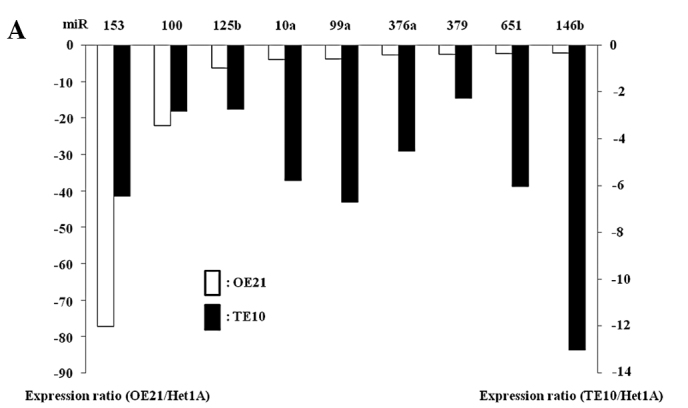
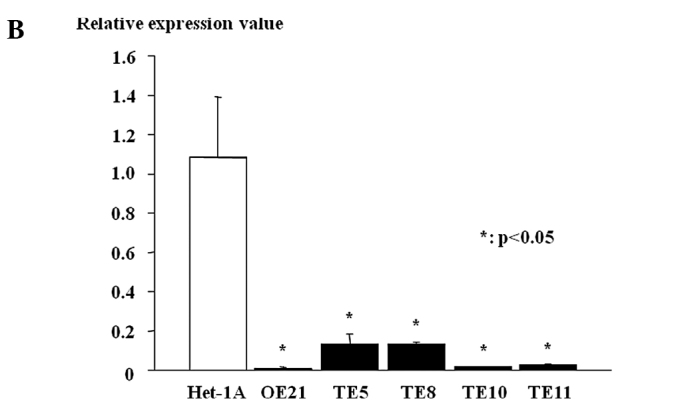
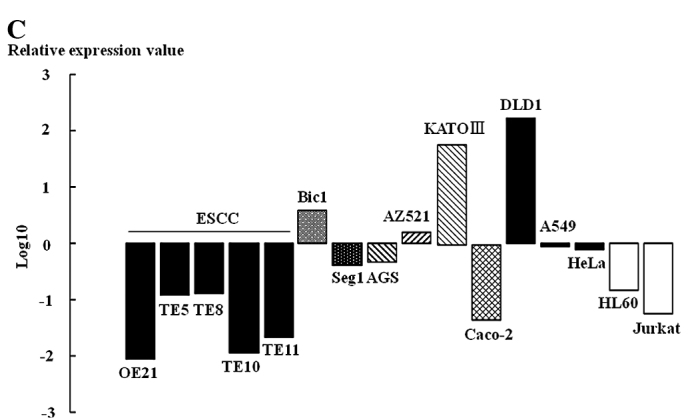

Based on microRNA (miR) microarray analysis, the expression of miR-153, -100, -125b, -10a, -99a, -376a, -379, -651, and -146b is significantly reduced in the two esophageal squamous cell carcinoma (ESCC) cell lines (OE21 and TE10) compared to Het1A cells (A). Quantitative reverse transcription (RT)-PCR shows a substantial decrease in the relative miR-10a expression levels in all ESCC cell lines (OE21, TE5, TE8, TE10 and TE11) compared to Het1A (B) and the Barrett’s adenocarcinoma cells (C and D). The miR-10a expression levels did not necessarily decrease in the ESCC cells compared to those in the remaining malignant cell types examined (C).
Down-regulation of microRNA-10a in esophageal high-grade intraepithelial neoplasm and non-invasive esophageal squamous cell carcinoma (carcinoma in situ)
MiR-10a expression in ESCC tumor samples and non-cancerous tissues was assessed using real-time RT-PCR (Fig. 2). Relative miR-10a expression levels were significantly lower in esophageal HGIN and tended to be low in non-invasive ESCC (carcinoma in situ), which were histopathologically classified according to the guidelines of the Japanese Esophageal Society for the diagnosis and treatment of ESCC (17), compared to the non-tumor mucosa. MiR-10a expression was heightened in the invasive ESCCs despite the results being insignificant.
Figure 2.
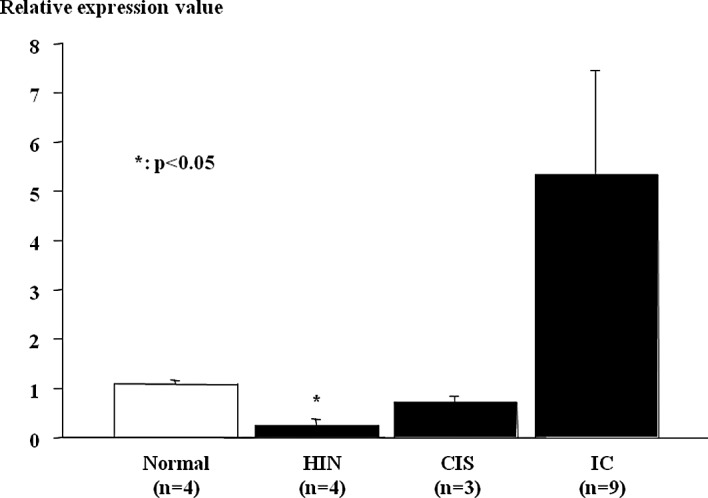
Quantitative RT-PCR analysis of miR-10a expression levels in the tumor samples and non-cancerous mucosa of the esophagus. The expression levels significantly decreased in high-grade intraepithelial neoplasms (HGIN) and tended to be low in non-invasive ESCC (carcinoma in situ, CIS), despite the results being insignificant. No difference was noted in the miR-10a expression levels between the invasive cancer (IC) phenotype and the other groups.
Restoration of microRNA-10a expression with 5-aza-2′-deoxycytidine treatment
Relative expression levels of miR-10a significantly increased in the presence of DAC, even at a concentration of 1 μmol/l in OE21 (Fig. 3). However, no increase was noted in the TE10 cells (data not shown). No significant effects on miR-10a expression were observed following incubation with TSA at a sufficient concentration in the cell lines (Fig. 3).
Figure 3.
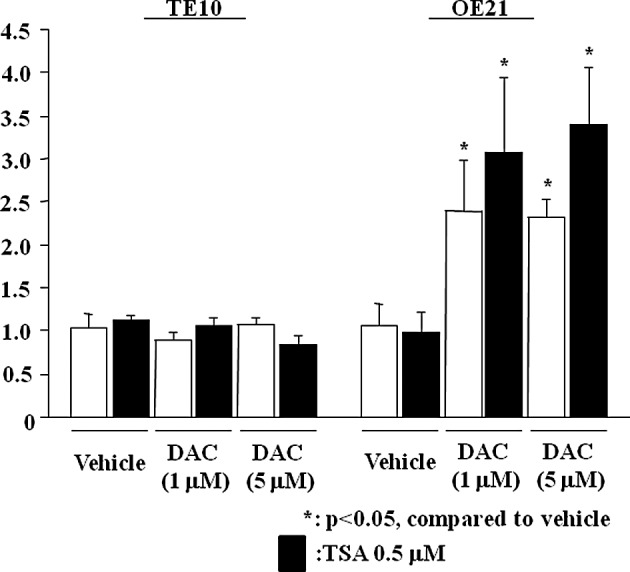
OE21 cells incubated with or without 5-aza-2′-deoxycytidine (DAC, 1 or 5 μmol/l) for 96 h, followed by treatment with 0.5 μmol/l trichostatin A (TSA) or vehicle for an additional 24 h. Total RNA was extracted and subjected to the quantitative RT-PCR to measure cellular miR-10a expression levels. Treatment with 1 μmol/l of DAC restored the miR-10a expression levels. TSA treatment did not affect miR-10a expression.
Discussion
In the present study, miR-10a was substantially down-regulated in ESCC cells. The miR-10a expression level was significantly lower in the ESCC cell lines examined compared to non-malignant esophageal squamous cells. In addition, miR-10a was substantially lower in the ESCC cells compared to those derived from esophageal adenocarcinoma, another significant type of esophageal cancer (2). Nevertheless, miR-10a expression did not necessarily decrease when compared with the remaining human malignant cell lines. These data implicate miR-10a in ESCC pathogenesis, and further functional analyses may shed light on the diagnostic and therapeutic potential of miR-10a against this malignant disease.
Down-regulation of miR-10a has been reported in chronic myeloid leukemia (CML) (18). Among 157 miRs tested using quantitative RT-PCR, miR-10a, along with miR-150 and miR-151, was listed in the significantly down-regulated miRs in CML cells compared to CD34-positive cells taken from healthy controls (18). The clinical relevance of this finding was shown in a group of 85 newly-diagnosed patients with CML in which the expression of miR-10a was down-regulated in 71% of cases (18). On the other hand, previous studies showed an overexpression of miR-10a in other cancers, including hepatocellular, pancreatic and urothelial carcinomas and acute myeloid leukemia (19–21). Based on the real-time PCR analysis and using RNA-extracted, formalin-fixed, paraffin-embedded, archival liver tissue, miR-10a expression levels were significantly increased in hepatitis C virus-associated hepatocarcinoma compared to normal liver parenchyma (19). Northern blot analysis showed increased expression levels of miR-10a in metastatic pancreatic adenocarcinoma (20). Weiss et al explored the metastatic behavior of primary pancreatic tumors and cancer cell lines in xenotransplantation experiments. These authors found that miR-10a expression promoted metastasis of the tumor cells, and the repression of this expression was sufficient to inhibit invasion and metastasis formation (20). The regulatory actions of miR-10a were mediated via its target inhibition of HOXB1 and HOXB3 expression (20), implying that miR-10a is a significant mediator of tumor metastasis. In the clinical settings, the present study showed a comparable down-regulation of miR-10a in HGIN and non-invasive ESCC, whereas it was highly expressed in the invasive ESCCs. The exact reasons for this discrepancy remain unknown, but the abundance of miR-10a expression may be involved in ESCC development and progression. There may be differential miR-10a expression in human cancers including ESCC, which may affect cellular transformation, carcinogenesis and aggressive behavior and act as an oncogene or tumor suppressor (11,13).
Transcriptional deregulation, epigenetic alterations, mutations in miR sequences, DNA copy number abnormalities and dysfunction in their biogenesis machinery may contribute to the aberrant expression of miRs in human cancers (22), though the underlying mechanisms remain unknown. Recent evidence has shown that epigenetic changes, including DNA methylation and histone modification, play important roles in regulating expression of not only protein-coding genes but also certain miRs (22,23). In the present study, treatment with a demethylating agent restored miR-10a expression in OE21 cells. Han et al compared miR expression profiles between human colon cancer cell line HCT 116 and its derivative, DNA methyltransferase 1 and 3b double knockout (DKO) cells, and found that the expression of approximately 10% of miRs may be regulated by DNA methylation (23). Of note is that miR-10a was the most strikingly up-regulated miR in the DKO HCT116 cells. Additionally, well-defined CpG islands are located within 3 kb upstream of the miR-10a gene locus. Bisulfite sequencing showed that the majority of CpG sites proximal to miR-10a were hypermethylated in the parent cell line, while DNA methylation was largely absent in the DKO cells (23). Thus, epigenetic regulatory mechanisms may be involved in miR-10a expression, at least in certain human cancer cells.
In conclusion, based on the comprehensive microarray analysis, following quantitative confirmation with the real-time RT-PCR procedure, miR-10a expression was specifically down-regulated in ESCC cells. miR-10a expression was comparably low in HGIN and non-invasive ESCC cells, whereas the expression levels increased in the invasive phenotypes, suggesting unique regulatory mechanisms for the differential expression of miR-10a. In this context, miR-10a expression is likely to be regulated via DNA methylation in the CpG islands proximal to its gene locus in certain ESCC cells.
References
- 1.Parkin DM, Bray F, Ferlay J, Pisani P. Global cancer statistics, 2002. CA Cancer J Clin. 2005;55:74–108. doi: 10.3322/canjclin.55.2.74. [DOI] [PubMed] [Google Scholar]
- 2.Crew KD, Neugut AI. Epidemiology of upper gastrointestinal malignancies. Semin Oncol. 2004;31:450–464. doi: 10.1053/j.seminoncol.2004.04.021. [DOI] [PubMed] [Google Scholar]
- 3.Mathé EA, Nguyen GH, Bowman ED, et al. MicroRNA expression in squamous cell carcinoma and adenocarcinoma of the esophagus: associations with survival. Clin Cancer Res. 2009;15:6192–6200. doi: 10.1158/1078-0432.CCR-09-1467. [DOI] [PMC free article] [PubMed] [Google Scholar]
- 4.Orringer MB. Multimodality therapy for esophageal carcinoma – an update. Chest. 1993;103:S406–S409. doi: 10.1378/chest.103.4_supplement.406s. [DOI] [PubMed] [Google Scholar]
- 5.Fareed KR, Kaye P, Soomro IN, et al. Biomarkers of response to therapy in oesophago-gastric cancer. Gut. 2009;58:127–143. doi: 10.1136/gut.2008.155861. [DOI] [PubMed] [Google Scholar]
- 6.Carthew RW, Sontheimer EJ. Origins and mechanisms of miRNAs and siRNAs. Cell. 2009;136:642–655. doi: 10.1016/j.cell.2009.01.035. [DOI] [PMC free article] [PubMed] [Google Scholar]
- 7.Schmittgen TD. Regulation of microRNA processing in development, differentiation and cancer. J Cell Mol Med. 2008;12:1811–1819. doi: 10.1111/j.1582-4934.2008.00483.x. [DOI] [PMC free article] [PubMed] [Google Scholar]
- 8.Rosenfeld N, Aharonov R, Meiri E, et al. MicroRNAs accurately identify cancer tissue origin. Nat Biotechnol. 2008;26:462–469. doi: 10.1038/nbt1392. [DOI] [PubMed] [Google Scholar]
- 9.Liang Y, Ridzon D, Wong L, Chen C. Characterization of microRNA expression profiles in normal human tissues. BMC Genomics. 2007;8:166. doi: 10.1186/1471-2164-8-166. [DOI] [PMC free article] [PubMed] [Google Scholar]
- 10.Croce CM. Causes and consequences of microRNA dysregulation in cancer. Nat Rev Genet. 2009;10:704–714. doi: 10.1038/nrg2634. [DOI] [PMC free article] [PubMed] [Google Scholar]
- 11.Lotterman CD, Kent OA, Mendell JT. Functional integration of microRNAs into oncogenic and tumor suppressor pathways. Cell Cycle. 2008;7:2493–2499. doi: 10.4161/cc.7.16.6452. [DOI] [PMC free article] [PubMed] [Google Scholar]
- 12.Calin GA, Dumitru CD, Shimizu M, et al. Frequent deletions and down-regulation of microRNA genes miR15 and miR16 at 13q14 in chronic lymphocytic leukemia. Proc Natl Acad Sci USA. 2002;99:15524–15529. doi: 10.1073/pnas.242606799. [DOI] [PMC free article] [PubMed] [Google Scholar]
- 13.Medina PP, Slack FJ. microRNAs and cancer: an overview. Cell Cycle. 2007;7:2485–2492. doi: 10.4161/cc.7.16.6453. [DOI] [PubMed] [Google Scholar]
- 14.Johnson SM, Grosshans H, Shingara J, et al. RAS is regulated by the let-7 microRNA family. Cell. 2005;120:635–647. doi: 10.1016/j.cell.2005.01.014. [DOI] [PubMed] [Google Scholar]
- 15.Bommer GT, Gerin I, Feng Y, et al. p53-mediated activation of miRNA34 candidate tumor-suppressor genes. Curr Biol. 2007;17:1298–1307. doi: 10.1016/j.cub.2007.06.068. [DOI] [PubMed] [Google Scholar]
- 16.He L, He X, Lim LP, et al. A microRNA component of the p53 tumour suppressor network. Nature. 2007;447:1130–1134. doi: 10.1038/nature05939. [DOI] [PMC free article] [PubMed] [Google Scholar]
- 17.Ono S, Fujishiro M, Niimi K, et al. Predictors of postoperative stricture after esophageal endoscopic submucosal dissection for superficial squamous cell neoplasms. Endoscopy. 2009;41:661–665. doi: 10.1055/s-0029-1214867. [DOI] [PubMed] [Google Scholar]
- 18.Agirre X, Jiménez-Velasco A, San José-Enériz E, et al. Down-regulation of hsa-miR-10a in chronic myeloid leukemia CD34+ cells increases USF2-mediated cell growth. Mol Cancer Res. 2008;6:1830–1840. doi: 10.1158/1541-7786.MCR-08-0167. [DOI] [PubMed] [Google Scholar]
- 19.Varnholt H, Drebber U, Schulze F, et al. MicroRNA gene expression profile of hepatitis C virus-associated hepatocellular carcinoma. Hepatology. 2008;47:1223–1232. doi: 10.1002/hep.22158. [DOI] [PubMed] [Google Scholar]
- 20.Weiss FU, Marques IJ, Woltering JM, et al. Retinoic acid receptor antagonists inhibit miR-10a expression and block metastatic behavior of pancreatic cancer. Gastroenterology. 2009;137:2136–2145. doi: 10.1053/j.gastro.2009.08.065. [DOI] [PubMed] [Google Scholar]
- 21.Garzon R, Garofalo M, Martelli MP, et al. Distinctive microRNA signature of acute myeloid leukemia bearing cytoplasmic mutated nucleophosmin. Proc Natl Acad Sci USA. 2008;105:3945–3950. doi: 10.1073/pnas.0800135105. [DOI] [PMC free article] [PubMed] [Google Scholar]
- 22.Deng S, Calin GA, Croce CM, Coukos G, Zhang L. Mechanisms of microRNA deregulation in human cancer. Cell Cycle. 2008;7:2643–2646. doi: 10.4161/cc.7.17.6597. [DOI] [PubMed] [Google Scholar]
- 23.Han L, Witmer PD, Casey E, Valle D, Sukumar S. DNA methylation regulates microRNA expression. Cancer Biol Ther. 2007;6:1284–1288. doi: 10.4161/cbt.6.8.4486. [DOI] [PubMed] [Google Scholar]


